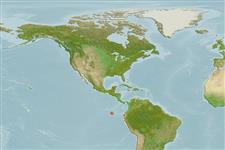Environment: milieu / climate zone / depth range / distribution range
Ecology
Marine; demersal; depth range 1 - 12 m (Ref. 55763). Tropical
Eastern Pacific: Ecuador to southern Peru. Also in the Eastern Central Pacific (Ref. 9342).
Size / Weight / Age
Maturity: Lm ? range ? - ? cm
Max length : 60.0 cm TL male/unsexed; (Ref. 55763); common length : 30.0 cm TL male/unsexed; (Ref. 55763)
Body elongate, not very deep, and little compressed; upper jaw lacking supramaxilla; teeth firmly placed; not folding back; lower branch of first gill arch with 12 to 15 gill rakers; 3 or 4 dorsal fin spines prolonged and filamentous; pelvic fins inserted slightly behind pectoral fins; anal fin with 7 soft rays; back light brown; belly pale; pectoral fins and prolonged dorsal spines reddish brown (Ref. 55763).
Found in mangrove areas as well as shallow inlets and bays (Ref. 5227).
Life cycle and mating behavior
Maturity | Reproduction | Spawning | Eggs | Fecundity | Larvae
CENAIM, 1992. A field guide to the edible fishes and shellfishes in coastal waters of Ecuador. Centro Nacional de Acuicultura e Investigaciones Marinas (CENAIM), Ecuador. 95 p. (Ref. 11035)
IUCN Red List Status (Ref. 130435)
Threat to humans
Harmless
Human uses
Fisheries: commercial
More information
Common namesSynonymsMetabolismPredatorsEcotoxicologyReproductionMaturitySpawningSpawning aggregationFecundityEggsEgg development
ReferencesAquacultureAquaculture profileStrainsGeneticsElectrophoresesHeritabilityDiseasesProcessingNutrientsMass conversion
Tools
Special reports
Download XML
Internet sources
Estimates based on models
Preferred temperature (Ref.
123201): 23.5 - 29.1, mean 27.6 °C (based on 151 cells).
Phylogenetic diversity index (Ref.
82804): PD
50 = 1.0000 [Uniqueness, from 0.5 = low to 2.0 = high].
Bayesian length-weight: a=0.01072 (0.00509 - 0.02256), b=3.06 (2.88 - 3.24), in cm total length, based on LWR estimates for this (Sub)family-body shape (Ref.
93245).
Trophic level (Ref.
69278): 4.2 ±0.73 se; based on food items.
Resilience (Ref.
120179): Very Low, minimum population doubling time more than 14 years (Preliminary K or Fecundity.).
Fishing Vulnerability (Ref.
59153): Moderate vulnerability (44 of 100).
Nutrients (Ref.
124155): Calcium = 102 [44, 221] mg/100g; Iron = 0.976 [0.521, 2.001] mg/100g; Protein = 17.9 [16.0, 19.6] %; Omega3 = 0.197 [0.111, 0.351] g/100g; Selenium = 37.9 [19.0, 87.2] μg/100g; VitaminA = 38.9 [11.6, 138.6] μg/100g; Zinc = 0.916 [0.627, 1.397] mg/100g (wet weight);
